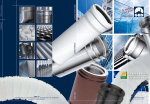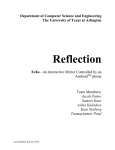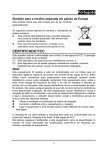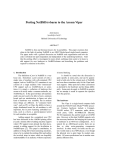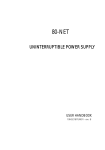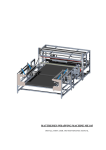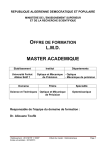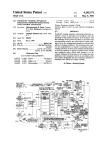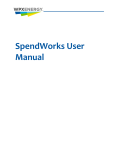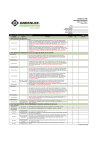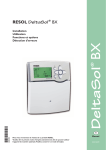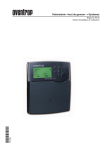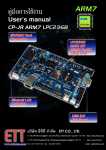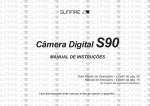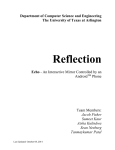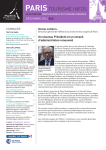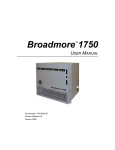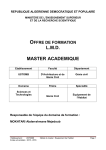Download System Test Plan - The University of Texas at Arlington
Transcript
Department of Computer Science and Engineering The University of Texas at Arlington Reflection Echo – Voice Controlled Interactive Mirror Team Members: Jacob Fisher Sumeet Kaur Aisha Kulindwa Sean Nesburg Tanmaykumar Patel Last Updated: October 16, 2014 System Test Plan Echo Table of Contents 1. Introduction ............................................................................................................................. 8 Document Overview ........................................................................................................ 8 Product Overview ............................................................................................................. 8 Project Description ........................................................................................................... 8 2. Test References ..................................................................................................................... 10 System Requirements Specification ............................................................................... 10 2.1.1 Customer Requirements ............................................................................................... 10 2.1.2 Packaging Requirements .............................................................................................. 11 2.1.3 Performance Requirements .......................................................................................... 12 2.1.4 Safety Requirements .................................................................................................... 12 2.1.5 Maintenance and Support Requirements ..................................................................... 13 2.1.6 Other Requirements ..................................................................................................... 14 Architectural Design Specification ................................................................................ 15 2.2.1 Layer Overview ........................................................................................................... 15 2.2.2 Subsystem Overview ................................................................................................... 17 2.2.3 Requirements Mapping ................................................................................................ 18 Detailed Design Specification ........................................................................................ 19 2.3.1 Module Overview ........................................................................................................ 19 2.3.2 Requirements Traceability ........................................................................................... 20 3. Test Items .............................................................................................................................. 24 Hardware Tests ............................................................................................................... 25 Unit Tests ....................................................................................................................... 26 Component Test ............................................................................................................. 32 Integration Tests ............................................................................................................. 35 4. Risk ....................................................................................................................................... 36 Risk Overview ................................................................................................................ 36 Risk Table ...................................................................................................................... 36 5. Features not to be tested ........................................................................................................ 37 System Test Plan Version 1.0 2 Reflection System Test Plan Echo Customer Requirements ................................................................................................. 37 Performance Requirements ............................................................................................ 37 Packaging Requirements ................................................................................................ 37 6. Features to Be Tested ............................................................................................................ 38 Customer Requirements ................................................................................................. 38 6.1.1 Android Control Application .................................................................................. 38 6.1.2 Display Multiple Application ................................................................................. 38 6.1.3 Switch between Applications .................................................................................. 38 6.1.4 Voice Recognition .................................................................................................. 38 6.1.5 How-To Application ............................................................................................... 38 6.1.6 Speakers Mounted on Echo .................................................................................... 39 6.1.7 Microphone ............................................................................................................. 39 6.1.8 Power Button .......................................................................................................... 39 Packaging Requirement.................................................................................................. 39 6.2.1 Mirror Housing ....................................................................................................... 39 6.2.2 Mirror Size .............................................................................................................. 39 6.2.3 Mirror Weight ......................................................................................................... 40 6.2.4 Power Cable ............................................................................................................ 40 Performance Requirement .............................................................................................. 40 6.3.1 Voice Command Recognition Latency ................................................................... 40 Safety Requirement ........................................................................................................ 40 7. 6.4.1 Installation............................................................................................................... 40 6.4.2 Packaging Safety..................................................................................................... 40 6.4.3 Heat Dissipation ...................................................................................................... 40 Testing Approaches .............................................................................................................. 41 Test Phases ..................................................................................................................... 41 7.1.1 Unit Test.................................................................................................................. 41 7.1.2 Component Test ...................................................................................................... 41 7.1.3 Integration Test ....................................................................................................... 41 7.1.4 System Validation Test ........................................................................................... 42 7.1.5 Hardware Test ......................................................................................................... 42 System Test Plan Version 1.0 3 Reflection System Test Plan Echo Test Metrics .................................................................................................................... 42 Test Tools ....................................................................................................................... 43 8. Item Pass/Fail Criteria........................................................................................................... 44 Hardware Tests ............................................................................................................... 44 Units Tests ...................................................................................................................... 44 Component Tests ............................................................................................................ 46 9. Test Deliverable .................................................................................................................... 47 System Test Plan ............................................................................................................ 47 Test Cases ....................................................................................................................... 47 Test Report ..................................................................................................................... 47 Bug Report ..................................................................................................................... 48 10. Test Schedule ..................................................................................................................... 49 11. Approval ............................................................................................................................ 50 System Test Plan Version 1.0 4 Reflection System Test Plan Echo Document Revision History Revision Number 0.1 1.0 Revision Date October, 5th 2014 October, 16th 2014 System Test Plan Version 1.0 Description Rationale STP First Draft Initial draft for STP STP After Review Baseline Submission 5 Reflection System Test Plan Echo List of Figures FIGURE PAGE Figure 1-1 General System Diagram .............................................................................................. 9 Figure 2-1: High Level Layer Definitions .................................................................................... 15 Figure 2-2 : Architecture Design Diagram ................................................................................... 17 Figure 2-3 : Detail Design Diagram.............................................................................................. 19 Figure 3-1: Relational Diagram .................................................................................................... 24 System Test Plan Version 1.0 6 Reflection System Test Plan Echo List of Tables TABLE PAGE Table 2-1: Architectural Requirements Mapping Table ............................................................... 18 Table 2-2 : Requirements Mapping For Input Layer .................................................................. 20 Table 2-3: Requirements mapping for Data Processing Layer ..................................................... 21 Table 2-4: Requirements mapping for Presentation Layer ........................................................... 22 Table 2-5: Requirements Mapping for Data Storage Layer.......................................................... 23 Table 3-1: Hardware Tests ............................................................................................................ 25 Table 3-2: Touch Input Unit Tests ................................................................................................ 26 Table 3-3: Voice Input Unit Tests ................................................................................................ 26 Table 3-4: Power Button Unit Tests ............................................................................................. 27 Table 3-5: Touch Input Processor Interfaces ................................................................................ 27 Table 3-6: Hardware Input Interfaces ........................................................................................... 28 Table 3-7: Data Processor Interfaces ............................................................................................ 29 Table 3-8: Output Manager Unit Test ........................................................................................... 29 Table 3-9: Echo Formatter Unit Test ............................................................................................ 30 Table 3-10: Phone Formatter Unit Test ........................................................................................ 30 Table 3-11: Data Formatter Unit Tests ......................................................................................... 31 Table 3-12: Data Storage Unit Tests ............................................................................................. 31 Table 3-13: Input Layer Component Test ..................................................................................... 32 Table 3-14: Data Processor Layer Component Tests ................................................................... 33 Table 3-15: Presentation Layer Component Tests ........................................................................ 34 Table 3-16: Data Storage Layer Component Tests ....................................................................... 34 Table 3-17: Integration Tests ........................................................................................................ 35 Table 4-1: Risk Table.................................................................................................................... 36 Table 8-1: Hardware Pass / Fail Criteria....................................................................................... 44 Table 8-2: Unit Tests Pass/Fail Criteria ........................................................................................ 45 Table 8-3: Component Test Pass/Fail Criteria .............................................................................. 46 Table 10-1: System Testing Schedule........................................................................................... 49 System Test Plan Version 1.0 7 Reflection System Test Plan Echo 1. Introduction Document Overview The System Test Plan will introduces various testing procedures that Team Reflection will follow to ensure that the Echo will perform to specifications set forth in the System Requirements Specification. This document will outline the procedures team Reflection will use to all acceptance criteria set forth in previous documents. In addition, this document will expand on the testing guidelines set forth in the Detailed Design and will go into detail of the hardware, unit, component, integration, and system validation testing. Product Overview Echo is a Smart Mirror that displays applications from a user’s phone to a mirror. The user will be able to choose which applications to display on the mirror and enlarge the application to see it in more detail. It achieves this using an ACA that communicates with and controls the Echo. Echo will give a better start to the day. The few minutes that you spend in front of the mirror looking at your reflection could be used more productively. While brushing your teeth you can inquire about weather, social updates, calendar events, emails, or even listen to music. Echo is designed for the average consumer who wishes to view information more easily than on their phone. The ACA will allow the user to select various apps that are on their AndroidTM phone. The selected apps will be displayed on the mirror and will allow the user to see updated information, similar to normal locked screen updates. An example is the busy student. They wake up, go to the bathroom to do their morning rituals, and they can see what their friends posted on Facebook, figure out how to get that perfect look for their presentation, play some upbeat music, and see what the weather is like, all while brushing their teeth and getting ready for the day. Project Description Echo will consist of two major components, the mirror and the ACA. The mirror will hold the display unit, speakers, microphone, and a motherboard. The display unit will be a LCD screen that will display user’s requests. The speakers will send sound from the music application or from the “How-To” application to the user. The microphone will allow the user to interact with the ACA using voice commands. The motherboard will analyze the voice commands and send it to the ACA and receive information from the ACA and make it into a display for the screen. The mirror itself will be a mountable box that will keep all components inside, while keeping moisture out and allowing sound to come in and heat to dissipate. The ACA will be the main interface between the applications and the user. It will take the commands, both voice and touch, and use it to interact with the applications. The ACA will also store the list of videos for the “How-To” application. System Test Plan Version 1.0 8 Reflection System Test Plan Echo Figure 1-1 General System Diagram System Test Plan Version 1.0 9 Reflection System Test Plan Echo 2. Test References The System Test Plan will be based on previous documents produced by team Reflection. These documents are the System Requirements Specification (SRS), Architecture Design Specification (ADS), and the Detailed Design Specification (DDS). The following sections and subsections will define for the reader our testing approach and will help the reader understand our system better. System Requirements Specification The SRS is the original requirements documentation which were created by the members of team Reflection and the sponsor, Dr. Becker. This document introduced the product, specified in detail what was needed for the product to be considered complete, and the purpose of the product. These requirements will be covered in this subsection. 2.1.1 Customer Requirements SRS No. Requirement Android Control 3.1 Application 3.2 Display Multiple Application Icons 3.3 Switch between Applications 3.4 Voice Recognition “How-To” Application 3.5 3.6 Speakers Mounted on Echo System Test Plan Version 1.0 Description It is an AndroidTM application that is used to control Echo system. It shall interact with other applications on the user’s phone and fetch data from those applications to display on the mirror. The AndroidTM Application and the mirror shall display multiple application icons on the main/opening screen. For example, Facebook, Weather, Calendar, Clock, Music and How-To app. The user can choose one of the available applications to open and display the large interface of the application on the mirror. The AndroidTM Application shall allow user to switch between the AndroidTM applications by either using the touch screen from phone or using voice command. The user can use voice commands to interact with Echo. The AndroidTM application associated with Echo will have an applet that allows the user to watch “How-to” videos such as “how to tie a tie”. This will allow the user to mimic the video while being able to see him or herself. All of the howto videos will be preselected. Echo shall have speakers mounted on to it. User shall be able to hear audio for videos and music. 10 Priority 1-Critical 1-Critical 1-Critical 2-High 1-Critical 1-Critical Reflection System Test Plan 3.7 3.8 Bluetooth Connectivity Pill Reminder Applet 3.9 Resolution and Brightness 3.10 Microphone 3.11 Power Button Echo Phone connects to mirror via Bluetooth. All the data transfer happens via Bluetooth. The AndroidTM application shall come with an applet that will let the user set reminders for pills and will allow the user to upload pictures of the pills. The user will be able to see the directions as well as the pictures of the pills they need to take that day. Echo will have a high enough resolution and be bright enough so that the user will be able to see all information displayed clearly. Echo will have a microphone built onto it. This will allow the user to interact with the ACA hands free. Echo will have an external power button to allow the user to conserve energy and to power down the system if desired 1-Critical 4- Low 2- High 1-Critical 1-Critical Table 2.1 Customer Requirements 2.1.2 Packaging Requirements SRS No. Requirement Mirror Housing 4.1 4.2 4.3 4.4 Mirror Size Mirror Weight Power Cable Description The components of Echo will be attached to the inside of the wooden housing to secure them in place. The housing will prevent any of the components from being exposed to the user. The housing will be rectangular in shape (wooden box). The housing will also have mount for the phone. The housing will keep moisture from entering Echo. Echo will be no larger than 44” x 24” x 8”. The weight of Echo will not exceed 50 lbs. The cable will be used as the source of power for the Echo. The power cable can be modular. Priority 2-High 3-Moderate 3-Moderate 1-Critical Table 2.2 Packaging Requirements System Test Plan Version 1.0 11 Reflection System Test Plan Echo 2.1.3 Performance Requirements SRS No. Requirement Smart Phone to 5.1 Mirror Synchronization Delay Smart Phone 5.2 Control Latency Description There will be a small delay of 1 to 2 seconds in the reaction of the screen synchronizing with the phone. 5.3 Internet API Interface Latency 5.4 Speaker Quality 5.5 Microphone Quality There will exist a small delay of up to a second between the input controls and the corresponding action of the mirror due to processing delay. The apps displayed on the mirror will be retrieving real time data from multiple websites. There will be a standard web service delay of on average 50-200ms delay in data query and display. Echo speakers must have high quality so that the user can clearly hear the system. The microphone mounted on Echo must be of high quality such that the voice commands are correctly interpreted by the system. Priority 3-Moderate 2-High 4-Low 2-High 2-High Table 2.3 Performance Requirements 2.1.4 Safety Requirements SRS No. Requirement Installation 6.1 6.2 Packaging Safety 6.3 Heat Dissipation Description The system shall include adequate anchors and screws such that it can be safely secured to the wall. The system shall be packaged such that there will be no exposed circuitry to the user. The system shall be able to dissipate the heat generated by the components of the system. Priority 1-Critical 1-Critical 2-High Table 2.4 Safety Requirements System Test Plan Version 1.0 12 Reflection System Test Plan Echo 2.1.5 Maintenance and Support Requirements SRS No. Requirement User Manual 7.1 7.2 Troubleshooting Guide 7.3 Application Updates 7.4 System Software Updates 7.5 Hardware Support & Maintenance 7.6 Source Code & Documentation Description The user manual will include step-by-step instructions on how to initially install the system as well as the accompanying mobile application. It will also include directions on how to use all of the features of the system. The system will come with a troubleshooting guide to identify some of the problems and recommend possible solutions to both hardware and software aspects of the system. The AndroidTM application accompanying Echo will receive updates to resolve bugs. The instructions will be included in the user manual. Echo system will receive updates directly via the accompanying AndroidTM application to resolve bugs. The instructions will be included in the user manual. The user may change any of the hardware used in Echo. All the specifics of the hardware used in the system will be included in the user manual. The instructions on replacing the hardware will be included in the troubleshooting guide. Any code written or used by the development team and any documentation for the system will be readily available for everyone to see post production. Priority 1-Critical 1-Critical 2-High 3-Moderate 3-Moderate 3-Moderate Table 2.5 Maintenance and Support Requirements System Test Plan Version 1.0 13 Reflection System Test Plan Echo 2.1.6 Other Requirements SRS No. Requirement Security and 8.1 Privacy 8.2 Bluetooth Range 8.3 AndroidTM Version Support Moisture Control 8.4 Description When communicating via BluetoothTM the AndroidTM application should ensure the security and privacy of the user information. The phone needs to be within the BluetoothTM range of Echo. There should be a clear line of sight between Echo and the phone for the most stable connection. The Application shall be designed to run on all AndroidTM versions between 4.0.3 and 4.4. Echo will prevent moisture from damaging components within the system. Priority 4-Low 2-High 1-Critical 2-High Table 2.6 Other Requirements System Test Plan Version 1.0 14 Reflection System Test Plan Echo Architectural Design Specification This subsection highlights the architecture outlined in the ADS. Providing details on the system’s overall components and structure. This is a high level overview and the subsections following need to be thoroughly tested, as to show the system’s architecture is working properly. 2.2.1 Layer Overview Figure 2-1: High Level Layer Definitions Input Layer The purpose of the Input Layer is to accept input from the user. The layer accepts input from the user through the phone’s touch screen. This will serve as a secondary source of input from the user to the system. Information from the AndroidTM Control Application (ACA) is sent to this layer where it is initially processed and then formatted. Once the data has been formatted it is passed to the next layer to be further processed. The Hardware Sub-Layer accepts data from the mirror microphone and the power button. This will serve as the main source of input from the user into the system. This layer will listen for the key command words spoken by the user. The information will go through an event handler in order to distinguish what actions need to be taken with the given input (every word after the key word “Echo” is collected). After the speech recognition has been formatted it is converted to strings to be sent out for processing. System Test Plan Version 1.0 15 Reflection System Test Plan Echo Data Processing Layer The purpose of the Data Processing Layer is to accept data that has been gathered through the input layers and to trigger events that correspond with the needs of the user. This layer contains components to analyze the data that is being received from the other layers. After the data has been analyzed, it is sent to the app command processor, where the command is processed into a request and sent to the Internet and database. The appropriate action will be generated and sent to the presentation layer. This layer also contains a component to deal with API requests to the Internet as well as their responses. Presentation Layer The purpose of the Presentation Layer is to present information to the user. This could be via LCD Screen, the speakers, or the Android™ Control application on the phone. Data to be output is sent from the Data Processing Layer to the Presentation Layer and is then routed to the correct output formatter based on the data received. After the data has been formatted to the correct medium it is presented to the user via that channel. Data Storage Layer The purpose of the Data Storage Layer is to store or retrieve data for the Data Processing Layer. The components inside this layer will facilitate saving or retrieving data as necessary. Data can flow in or out of this layer. Data flowing in from the Data Processing Layer will be converted to a more suitable format for being saved on the file system. Data flowing out will be converted from its file format to a data structure that the Data Processing Layer can use. System Test Plan Version 1.0 16 Reflection System Test Plan Echo 2.2.2 Subsystem Overview Figure 2-2 : Architecture Design Diagram System Test Plan Version 1.0 17 Reflection System Test Plan Echo 2.2.3 Requirements Mapping Requirement Number Requirement Name Input Layer 3.1 AndroidTM Control Application Display Multiple Application Icons Switch between Applications Voice Recognition “How-To” Application Speakers Mounted on Echo Bluetooth Connectivity Resolution and Brightness Microphone Power Button Pill Reminder Applet 3.2 3.3 3.4 3.5 3.6 3.7 3.8 3.9 3.10 3.11 Data Processing Layer Data Storage Presentation Layer Table 2-1: Architectural Requirements Mapping Table System Test Plan Version 1.0 18 Reflection System Test Plan Echo Detailed Design Specification 2.3.1 Module Overview Figure 2-3 : Detail Design Diagram System Test Plan Version 1.0 19 Reflection System Test Plan Echo 2.3.2 Requirements Traceability Input Layer Requirement Number Requirement Name GUI Listener 3.1 AndroidTM Control Application Display Multiple Application Icons Switch between Applications Voice Recognition “How-To” Application Speakers Mounted on Echo Server Connectivity Resolution and Brightness Microphone Power Button Pill Reminder Applet 3.2 3.3 3.4 3.5 3.6 3.7 3.8 3.9 3.10 3.11 Event Handler Echo Activation Service Speech Recognizer System Power Table 2-2 : Requirements Mapping For Input Layer System Test Plan Version 1.0 20 Reflection System Test Plan Echo Data Processing Layer Requirement Number Requirement Name Request Processor 3.1 AndroidTM Control Application Display Multiple Application Icons 3.3 Switch between Applications 3.4 Voice Recognition “How-To” Application 3.2 3.5 3.6 Speakers Mounted on Echo 3.7 Server Connectivity 3.8 Resolution and Brightness 3.9 Microphone 3.10 Power Button 3.11 Pill Reminder Applet Command Validation Command Processor Request Handler App Request Processor Table 2-3: Requirements mapping for Data Processing Layer System Test Plan Version 1.0 21 Reflection System Test Plan Echo Presentation Layer Requirement Number Requirement Name Dispatcher Phone Formatter Speaker Formatter 3.1 AndroidTM Control Application 3.2 Display Multiple Application Icons 3.3 Switch between Applications 3.4 Voice Recognition 3.5 “How-To” Application 3.6 Speakers Mounted on Echo 3.7 Server Connectivity 3.8 Resolution and Brightness 3.9 Microphone 3.10 Power Button 3.11 Pill Reminder Applet Echo Formatter Table 2-4: Requirements mapping for Presentation Layer System Test Plan Version 1.0 22 Reflection System Test Plan Echo Data Storage Layer Requirement Number Requirement Name 3.1 AndroidTM Control Application 3.2 Data Parser Data Request Formatter Data Retrieval Data Storage Display Multiple Application Icons 3.3 Switch between Applications 3.4 Voice Recognition 3.5 “How-To” Application 3.6 Speakers Mounted on Echo 3.7 Server Connectivity 3.8 Resolution and Brightness 3.9 Microphone 3.10 Power Button 3.11 Pill Reminder Applet Table 2-5: Requirements Mapping for Data Storage Layer System Test Plan Version 1.0 23 Reflection System Test Plan Echo 3. Test Items This section details the separate subsystems of the Echo Mirror system and their tests. Each table with show their unique test ID, the component or module being tested, the input that will take, the expected output when that input is used, and how to test that specific module or component. The tests will be composed of different tests, including unit tests for each module, hardware tests for the systems physical components, integration tests for system interfaces, and system validation tests to ensure the system performs correctly. Figure 3-1: Relational Diagram System Test Plan Version 1.0 24 Reflection System Test Plan Echo Hardware Tests Test ID HW1 Test Input Component Microphone The user speaks into the microphone. Expected Output The microphone accepts and records the words the user says. HW2 Speaker The user brings up music on the Echo system. The system should play the music through the speakers. HW3 Screen The user will press the power button on the Echo system. The system will turn the screen on and display the home screen of the ACA HW4 Android TV The user will Box press the power button on the Echo system. The system will turn the Android TV box on and start the ACA Test Requirements Satisfied 3.4, 3.10 Test the microphones output by checking the output log of the microphone and ensure it is recording the words being said. Test the speakers 3.3, 3.6 by telling the Echo system to play music, and ensure it plays the music appropriately. Test the screen by 3.2, 3.9, 3.11 pressing the power button on the side of the Echo system to ensure it turns on and off. Test the screen by 3.1 pressing the power button on the Echo System to ensure it turns on and off. Table 3-1: Hardware Tests System Test Plan Version 1.0 25 Reflection System Test Plan Echo Unit Tests 3.2.1 Touch Input Subsystem Test ID UTI1 Module Input GUI Listener User touch screen input. Expected Output Identified touch screen action. UTI2 Event Handler Application Check lists, sync button status List of selected applications and a sync button activation call. Test Priority Test the GUI listener by typing, tapping, or sliding on the screen, ensuring it correctly identifies each action. Test the Event Handler by selecting applications from the home screen list and pressing the sync button, ensuring the correct applications are displayed on the screen. Critical Critical Table 3-2: Touch Input Unit Tests 3.2.2 Voice Input Subsystem Test ID UVI1 Module Input Echo Activation Service User says Echo UVI2 Speech Recognizer User says command Expected Output Speech Recognition activation signal and audio beep to confirm Echo was recognized. Tokenized voice input in the form of a text string matching users vocal command. Test Priority Test the Echo Activation Service by saying the word “Echo” while the system is on. Test after “Echo” has been said by speaking any command. Critical Critical Table 3-3: Voice Input Unit Tests System Test Plan Version 1.0 26 Reflection System Test Plan 3.2.3 Echo Power Button Subsystem Test Module ID UPB1 System Power Input User presses the external system power button. Expected Output If the system is off, the screen turns on and the ACA starts. Test Priority Test the power button subsystem by pressing the power button, ensuring the system turns on and off. Critical Table 3-4: Power Button Unit Tests 3.2.4 Touch Input Processor Subsystem ID UTIP1 Module Request Processor Input List of Applications Output JSON Object UTIP2 Request Processor List of Applications App Icons Test Method Priority We will provide the Critical module with a List of Applications and verify if the module outputs a JSON object. We will provide the Medium module with a list of selected applications and verify if it displays the application icons on the next screen on the phone. Table 3-5: Touch Input Processor Interfaces System Test Plan Version 1.0 27 Reflection System Test Plan Echo 3.2.5 Hardware Input Processor Subsystem ID Module Input UHIP1 Command String Validator Output Parsed String UHIP2 System Boot up Android OS call Digital Signal Test Method Priority We will provide the Critical Module with a string command and verify if is parses the string by picking the key commands. We will provide the Critical Module with a digital signal and verify if it starts ACA on Boot up. Table 3-6: Hardware Input Interfaces 3.2.6 Data Processor Subsystem ID UDP1 Module Server Input JSON Object Output JSON Object UDP2 Request Handler JSON Object Array List of Apps with package Info UDP3 Request Handler Table Request UDP4 Command Processor String String System Test Plan Version 1.0 28 Test Method We will provide the module with a JSON object and verify if it outputs the other JSON object on ACA of mirror. We will provide the module with JSON object that has list of apps to pull the information and we will verify if the module pulls the package info for the requested Apps. We will provide this module with Table of favorite Apps and will verify that it shows the Icons to the user. We will provide this module with a valid string and verify that it sends the string to Application request processor to perform the action. Priority Critical Critical Critical Reflection System Test Plan UDP5 Command Processor UDP6 Echo String None We will provide the module with a valid command and verify if it discards the command since it will be invalid for the situation. Medium Application Android Request OS Call Processor ACA interface Critical UDP7 Application Request Request Processor Application Data UDP8 Application AppMessa InterfaceReq Request ge Object uest Object Processor The Module will be provided with Android OS call to open ACA and we will verify if it opens the App on boot up. We will provide the module with Voice Command in form of String and verify if performs the requested action. We will provide the Module with AppMessage (“Next Page”) object and verify the module returns the data requested. Critical Critical Table 3-7: Data Processor Interfaces 3.2.7 Output Manager Test ID Model UOM1 Input Excepted Results Dispatcher Application Application data interface Test Description Priority We will provide the method with application interface and verify if it displays it on screen High Table 3-8: Output Manager Unit Test System Test Plan Version 1.0 29 Reflection System Test Plan Echo 3.2.8 Echo Formatter Test ID Model Input Excepted Results Test Description Priority Sound data High UEF1 Speaker Formatter Audio File path UEF2 Display Formatter Application Display data data to display We will provide the method with a test audio path and see if it will play the audio file. We will provide the method with a test string of display data and see if it will correctly display data passed High Table 3-9: Echo Formatter Unit Test 3.2.9 Phone Formatter Test ID UPF1 Model Display Formatter Input Excepted Results Application Display data data to display Test Description Priority We will provide the method with a test string of display data and see if it will correctly display data passed High Table 3-10: Phone Formatter Unit Test System Test Plan Version 1.0 30 Reflection System Test Plan Echo 3.2.10 Data Formatter Test ID Model Input Excepted Results Test Description Priority We will provide the subsystem with a string and see if the request is properly sent to the data storage manager We will provide the subsystem with test strings and see if it combines it correctly and sends it to the correct module High UDF1 Data Parser String String request UDRF3 Data Request Formatter Strings Application Data High Table 3-11: Data Formatter Unit Tests 3.2.11 Data Storage Test ID Model Input Excepted Results Test Description Priority We will send requests to the data base to retrieve data We will provide the subsystem with a test string and see if it stores the information in the right location We will receive data from the database from dummy requests High UDS1 Data Storage String String from database UDS2 Data Storage Strings Strings into database UDS3 Data Retrieval String String from database High High Table 3-12: Data Storage Unit Tests System Test Plan Version 1.0 31 Reflection System Test Plan Echo Component Test 3.3.1 Input Layer Test ID CIL1 Subsystem Input Expected Output Touch Input Phone touch Touch screen screen commands, input. application selection lists, and sync command. CIL2 Voice Command User voice input. System command in the form of a text string. CIL3 Power Button Pressing the external power button. The Echo screen and Android TV box both turn on. Test Priority Test the touch input Critical subsystem by testing various touch screen inputs on the screen (such as tapping and sliding), ensuring the correct buttons and commands are registered. Test the voice Critical command subsystem by activating it with the “Echo” keyword, then saying a system command. Test the power Critical button subsystem by pressing the power button and ensuring the system turns on. Table 3-13: Input Layer Component Test System Test Plan Version 1.0 32 Reflection System Test Plan Echo 3.3.2 Data Processing Layer ID CTIP1 Subsystem Touch Input Processor Input List of Applications CHIP2 Hardware Input Processor String voice or system startup command CDP3 Data Processor JSON object CDP4 Data Processor String voice command CDP5 Data Processor Android system call Output JSON Object Test Method We will provide the subsystem with dummy data of array Lists and verify if the array list gets converted into the JSON object. String or We will provide the Android subsystem with voice system call commands and verify if the commands are processed correctly. We will also test if on startup the system makes an android system call. Application We will test and verify that Icons the subsystem takes in the JSON object, performs the conversion and search and displays the application icons on the screen. Third party We will test this subsystem Application by sending a string Interface command like “open calendar” and verify if it opens the application and displays it on the screen. ACA We will test this subsystem Application by providing startup Interface command and verify if the subsystem opens the ACA on startup. Priority Critical Critical High Critical High Table 3-14: Data Processor Layer Component Tests System Test Plan Version 1.0 33 Reflection System Test Plan Echo 3.3.3 Presentation Layer Test ID Subsystem Input Excepted Results CPL1 Output Manager Application data Application interface CPL3 Echo Formatter String of data to display Display data CPL4 Echo Formatter String of audio file path Sound data CPL5 Phone Formatter String of data to display Display data Test Method Priority We will provide the method with application interface and verify if it displays it on screen We will provide the subsystem with string of data and expect it to display the formatted data passed We will provide the subsystem with a string of file path and see if the right file will be played We will provide the subsystem with string of data and expect it to display the formatted data passed High High High High Table 3-15: Presentation Layer Component Tests 3.3.4 Data Storage Layer Test ID Subsystem Input Excepted Results CDSL1 Data Storage Manager String String to the database CDSL2 Data Formatter Strings Strings to Array List Test Method We will send data into the sub system and see if the data is stored into the database correctly We will see if the sub system will package the correct information together and send it correctly Priority High High Table 3-16: Data Storage Layer Component Tests System Test Plan Version 1.0 34 Reflection System Test Plan Echo Integration Tests Test ID Layer Input I1 Input Layer User interaction Application with ACA Selection list in the form of an arrayList I2 Input Layer User voice input I3 Input Layer User interaction Power to the with external screen and power button Android TV box I4 Data Processing Layer Data Processing Layer Parsed Voice Application command Interface JSON Object Application Icons Data Storage Layer Data Storage Layer ArrayLists None Request Application Information Presentation Layer Application Application Interface I5 I6 I7 I8 Output Parsed voice command string Test Method Priority The ACA will be tested through a variety of touch screen inputs, including sliding across and tapping the screen. Testing of the Echo systems voice input shall be through a variety of voice commands, both those known to the system and those that the system will not recognize. The external power button will be tested by confirming power to the screen and Android TV box is turned on and off by pressing the button. We will provide the Layer with parsed voice command and verify if the We will provide the layer with JSON object and verify if it displays the Application Icons of the selected apps on the Screen Critical We will send data to the layer and see if it properly stores it into the database We will verify this by requesting data from the database and see if the layer packages it correctly and sends it to the proper location Critical Critical Critical Critical High Critical We will provide the method High with a test string of display data and see if it will correctly display data passed Table 3-17: Integration Tests System Test Plan Version 1.0 35 Reflection System Test Plan Echo 4. Risk Risk Overview This section will go through the risks that we might encounter as we test the Echo. The table below will show specific risks that may affect testing and or the test outcome. It will also show impact assessment and management plan as it relates to these risks. Risk Table Risk ID Description Impact Severity Mitigation R1 Trickle down error It will make it very hard to detect where the fault is from. Medium R2 Failure of external software or third party application Hardware Failure This cannot be fixed by us High the developers and it can also cause the test to give out undesired output To make sure the interfacing object requested are the same and catch the error early by doing unit testing, component testing and finally integrated test We are having the third party application to work independent of the rest of the system after they are called. We are testing the hardware separately to see if they work with other applications before we test it will our system. We will check if the server connection before we send the settings. R3 R4 Server Connection error This may cause the component test to not produce any outcome at all or produce undesired outcome. This may cause settings not be sent to the echo from the phone High Medium Table 4-1: Risk Table System Test Plan Version 1.0 36 Reflection System Test Plan Echo 5. Features not to be tested This section details what requirements will not be tested and why. Largely, most requirements not being tested are simply those not being implemented, but to clarify each requirement will explain why it is not being tested. Customer Requirements 5.1.1 Pill Reminder Applet Description: The AndroidTM application shall come with an applet that will let the user set reminders for pills and will allow the user to upload pictures of the pills. The user will be able to see the directions as well as the pictures of the pills they need to take that day. Reason: The pill reminder applet will not be implemented in the final product Performance Requirements 5.2.1 Smart Phone to Mirror Synchronization Delay Description: There will be a small delay of 1 to 2 seconds in the reaction of the screen synchronizing with the phone. Reason: The synchronization action will not be taking place as frequently as other integral systems. The only thing when it comes to synchronizing the mirror and smart phone being tested is whether or not it is actually synchronizing. 5.2.2 Internet API Interface Latency Description: The apps displayed on the mirror will be retrieving real time data from multiple websites. There will be a standard web service delay of on average 50-200ms delay in data query and display Reason: This will be irrelevant to test, as internet service will differ depending on where the system is installed. Packaging Requirements 5.3.1 User Manual Description: There will be user manual provided with the system, with installation instructions. Reason: This feature will not be tested as it will be included in the final product. System Test Plan Version 1.0 37 Reflection System Test Plan Echo 6. Features to Be Tested The following section will describe all the features based on the requirements stated in the System Requirement Specifications that need to be tested. Customer Requirements 6.1.1 Android Control Application Description: Echo shall have an Android Control Application that is associated with it. It will be used to control the Echo system by allowing the user to configure the applications that he/she wishes to display on Echo. Test Approach: The application (ACA) will be installed on an Android based device, and it will be used to connect with the Echo. Applications will be selected on ACA and then the ACA will be synced with the Echo to transfer the settings and determine if the user configurations have been correctly set. 6.1.2 Display Multiple Application Description: Echo will be able to display multiple applications on its Home Screen. The user can choose one of the available application to open and display the large interface of the application on the mirror. Test Approach: The team will test to see if multiple applications are being displayed on the home screen of Echo. Also, the team will open each of the applications and see if it is being displayed in its full version. 6.1.3 Switch between Applications Description: The Echo will allow the user to switch between the applications that they are currently using. Test Approach: The team will test Echo to see if it is allowing a user to switch from the current applications to a different application that is available to them. 6.1.4 Voice Recognition Description: The user will be able to interact with Echo using voice commands. Test Approach: The team will use pre-selected voice commands to interact with the Echo in order to test this requirement. 6.1.5 How-To Application Description: Echo will have an application that will allow the user to watch preselected How-To videos that are hosted on YouTube. System Test Plan Version 1.0 38 Reflection System Test Plan Echo Test Approach: The team will test to see if Echo has the how-to application on it, if it is on Echo, the team will open the How-To application and play one of the pre-selected how-to videos. Afterwards, the team will test the functionality of How-To by closing the video and opening up another video from the pre-selected video. 6.1.6 Speakers Mounted on Echo Description: Echo will have speakers mounted on to it. User will be able to hear audio for videos and music. Test Approach: The team will play music or a video on the Echo to see if they can hear any audio coming out of the speakers. 6.1.7 Microphone Description: Echo will have a microphone built onto it. This will allow the user to interact with the ACA using voice commands. Test Approach: The team will speak voice commands into the microphone to test that it is able to take in audio input clearly and correctly. 6.1.8 Power Button Description: Echo will an external power button to allow the user to conserve energy and to power down and power up the system. Test Approach: The team will test this by pushing the button on the Echo and see if turns off the system, and then push it again to see if it turns the system back on. Packaging Requirement 6.2.1 Mirror Housing Description: The components of Echo will be attached to the inside of the wooden housing to secure them in place. The housing will prevent any of the components from being exposed to the user. Test Approach: The components will be tested to make sure that they are securely attached to the insides of the Echo housing. The team will see that none of the hardware that is used will be exposed to the user. 6.2.2 Mirror Size Description: Echo will be no larger than 44” x 24” x 8”. Test Approach: The team will measure that the housing is same or less than the measurements shown above. System Test Plan Version 1.0 39 Reflection System Test Plan 6.2.3 Echo Mirror Weight Description: The weight of Echo will not exceed 50lbs. Test Approach: This will be tested by measuring the weight of Echo. 6.2.4 Power Cable Description: The cable will be used as the source of power for the Echo. The power cable can be modular. Test Approach: The team will use the power cable by plugging it into the wall outlet and test that it supplies the power to the system by turning the system on. Performance Requirement 6.3.1 Voice Command Recognition Latency Description: There will exists a small delay up to a second between the input of the voice command and the action that is performed based on the voice command. Test Approach: The team will test using a stop watch that the delay between the input of the voice command and action being performed by Echo is less than 1 second. Safety Requirement 6.4.1 Installation Description: The system shall include adequate anchors and screws such that it can be safely secured to the wall. Test Approach: The team will install the Echo onto a wall to test that is it securely mounted. 6.4.2 Packaging Safety Description: The system shall be packaged such that there will be no exposed circuitry to the user. Test Approach: The team will test this requirement by testing that there is no exposed circuitry to the user. 6.4.3 Heat Dissipation Description: The system shall be able to dissipate the heat generated by the components of the system. Testing Approach: The team will test this by measuring the heat inside the Echo and determine that it’s under the recommended temperature. System Test Plan Version 1.0 40 Reflection System Test Plan Echo 7. Testing Approaches The following section will describe the overall approach and strategy on testing Echo. Echo will be tested for completeness on the requirements stated in the SRS. The section will also detail when Echo will be considered complete. Test Phases 7.1.1 Unit Test As each of the subsystems are being developed, the unit tests will be performed on each of the modules of every subsystem by the members developing that particular module. 7.1.2 Component Test Component tests will be performed on each of the subsystems, and will also be done by the team members that developed that particular subsystem. The following list shows the subsystems that will be tested: 7.1.3 Touch Input Subsystem Voice Command Subsystem Power Input Subsystem Touch Input Processor Subsystem Hardware Input Processor Subsystem Data Processor Subsystem Data Formatter Subsystem Data Storage Manager Subsystem Output Manager Subsystem Phone Formatter Subsystem Echo Formatter Subsystem Server Integration Test Integration testing will be done by combining all of the modules into their respective subsystem and then testing those subsystems. This test will be done to verify the integrity of all inter-subsystem and interlayer interfaces and interactions. Each layer will be tested to ensure that they perform their function as stated in the Detailed Design Specification. System Test Plan Version 1.0 41 Reflection System Test Plan 7.1.4 7.1.5 Echo System Validation Test The final test that will be done on the system will be the validation tests. It will ensure that all of the requirements by the customer and the development team mentioned in the SRS are met. It will validate that the functionality of the Echo is exactly as stated in the requirements. Hardware Test As the applications needed for the Echo are being developed, the hardware that goes along side it will also be assembled and tested. Each hardware piece will be tested individually and then they will be tested again after integrating them with other hardware pieces and the software apps. Test Metrics Priority Critical High Moderate Low Description These features must be completed for they are critical to the functionality of the system. The system would not be able to function without them. These are the noncritical features of the system. The system will have some functionality without them, but they should be completed for greater user experience. These would have moderate impact on the user experience. These features do not impact the performance of the system and are considered to be for future plans. System Test Plan Version 1.0 42 Pass Criteria 100% Fail Criteria Less than 100% 90% Less than 90% 75%+ Less than 75% 0%+ N/A Reflection System Test Plan Echo Test Tools Team Reflection will be using the following tools for testing: Excel JUnit GitHub System Test Plan Version 1.0 43 Reflection System Test Plan Echo 8. Item Pass/Fail Criteria The following section will determine the criterion needed for the module test to be accepted as passing or failing. Only the modules that have passed will be accepted into the final Echo product, the failed modules will be corrected in order to be acceptable. Hardware Tests Test ID HW1 Component Microphone Pass Criteria Correctly intakes the voice commands and sends it to the system HW2 Speaker HW3 Screen HW4 Android TV Box Correctly outputs the audio It turns on o power connection and displays the ACA It turn on once connected to power and to the screen and shows all the Apps. It lets the user install more applications from play store. Fail Criteria Does not intake the voice commands or sends wrong commands Does not output audio It does not turn on or display the ACA It does not turn on or show the installed apps or does not let the team install more apps. Table 8-1: Hardware Pass / Fail Criteria Units Tests Test ID UTI1 UTI2 UVI1 UVI2 Pass Criteria Be able to detect keyboard input, and touch input by screen tap or slide. Be able to create list of apps from the selections made by the user. Be able to recognize the command word “Echo” from the user. Be able to tokenize the voice commands into corresponding strings. System Test Plan Version 1.0 44 Fail Criteria Fails to detect keyboard input, or touch input by screen tap and slide. Fail to create a list of apps from the selection, or create incorrect lists from Fail to recognize the command word or activate on a wrong command word. Fail to tokenize the voice commands or tokenize the voice commands incorrectly into string. Reflection System Test Plan UPB1 UTIP1 UTIP2 UHIP1 UHIP2 UDP1 UDP2 UDP3 UDP4 UDP5 UDP6 UDP7 UDP8 UOM1 UOM2 Echo Be able to turn on the system when the system is off, and vice-versa. Be able to create a JSON object from a list of applications correctly. Be able to display the list of selected applications on phone screen. Be able to parse the string and remove all of the words that are not command words. Be able to turn on the ACA on the echo on system boot up. Be able to connect and send JSON object over the Wi-Fi. Be able to parse the JSON object and retrieve package info for the applications found in JSON object. Be able to show the icons of the favorite’s app to the user on Echo. Be able to send the string command to application processor if the command is valid for the situation Be able to discard the string commands if they are invalid for the situation. Be able to turn on the ACA on the echo on system boot up. Be able to perform the requested action based on string command. Be able to display the requested application data Be able to display information on Echo correctly. Be able to output audio on speakers properly. Fail to turn on the system when the system is off or fail to turn off the system when the system is on. Fail to create a JSON object from the list of applications, or create JSON object incorrectly. Fail to display the list of applications, or display incorrect icons for applications. Fail to parse the string correctly, by either removing command words, or not removing words that are not commands. Fail to turn on the ACA on boot up. Fail to connect, or fail to send the JSON object correctly over the WiFi. Fail to parse the JSON object correctly, or fail to retrieve the package information correctly. Fail to show the icons of the favorite’s app to the user. Fail to send the string command or send the string command even if the commands aren’t valid for the situation Fail to discard the commands if they are invalid for the situation, or discard the commands even if they are valid. Fail to turn on the ACA on boot up. Fail to perform the requested action based on the string command. Fail to display the requested application data Fail to display information on Echo correctly. Fail to output audio speakers properly. Table 8-2: Unit Tests Pass/Fail Criteria System Test Plan Version 1.0 45 Reflection System Test Plan Echo Component Tests Test ID CTI1 Subsystems Touch Input Pass Criteria Input from ACA is recognized and processed CVCI2 Voice Command Input The command word is recognized when spoken and voice commands are recognized CPB3 Power Button Input CTIP1 Touch Input Processor CHIP2 Hardware Input Processor The power button press is recognized and TV box is turned on The JSON object is made and transferred to the Server on Echo correctly. The voice commands are parsed and validated CDP3 Data Processor JSON object is retrieved and parsed and tables of relevant information are created for storage. CDP4 Data Processor The voice commands are acted upon and proper action is taken upon the applications CDP5 Data Processor COM1 Output Manager The System makes an Android System call after the startup button is pressed. The subsystem displays the Application interfaces on the Screen correctly. Fail Criteria Input from ACA is not recognized or not processed The command word is not recognized by the subsystem, or the voice commands are not being processed The power button input is not recognized and the TV box doesn’t turn on. The JSON object is not made, or the transfer does not happen correctly. The voice commands are not parsed properly, or not validated correctly. JSON object is not retrieved or the proper tables are not being created, or are created incorrectly. The voice commands are not being acted upon, or the incorrect actions are being performed on applications It does not make an Android system call The subsystem will not display application Interface on the screen. Table 8-3: Component Test Pass/Fail Criteria System Test Plan Version 1.0 46 Reflection System Test Plan Echo 9. Test Deliverable This section will list what is to be delivered by this test plan that is system test plan, test cases, test report and Incident/Bug/Problem Reports (IRs). Under each subsection we will list the parts that go with them. System Test Plan The System Test Plan will provide an overview of what will be tested, how it will be tested, and the pass/fail criteria for each test depending on the expected input/outcome Test Cases Each test case will consist of the following section. Test ID: The ID corresponding to the test case Test Item: The name of the subsystem/module to test Purpose: Reasoning for the test Test Description: a short summary of what will be done as part of the test Input: Input that will be supplied to the test item Expected Results: Expected result of the test Priority: The priority of the test (low, medium, high, Critical) Test Report Each of the test report will consist of the following section. Test ID: The ID corresponding to the test case Test Date: The date when the test will be performed Tester: The name of the team member performing and recording test report Output Results: what the test yield as results Pass/fail Criteria: Criteria if the test passed of failed Comment: Any comments relevant to the test as well as a description of any errors System Test Plan Version 1.0 47 Reflection System Test Plan Echo Bug Report Each of the bug report will consist of the following section. Bug ID – A unique ID for each bug Test ID: The ID corresponding to the test case Test Date: The date the bug was first observed Priority: The priority of the bug to be fixed with respect to severity (low, medium, high, critical) Tester: Name of team member performing and recording test report Fixer: Name of team member who fixed the bug Bug Description: A short summary about the bug and what caused it. Resolution Date: When the bug was fixed Bug Comments: Any comments on the bug or defect System Test Plan Version 1.0 48 Reflection System Test Plan Echo 10. Test Schedule Task Name Planned Start Date Planned Due Date Hardware Testing Unit Testing GUI Listener Testing Event Testing Request Processor Testing Voice Input Testing Command Validator Testing Command Processor Testing Power Button Testing Request Handler Testing Application Request Processor Testing System Boot Up Testing Data Formatter Testing Data Storage Testing Dispatcher Testing Display Formatter Testing Speaker Formatter Testing Component Testing Touch Input Testing Voice Input Testing Power Input Testing Touch Input Processor Testing Hardware Input Processor Testing Data Processor Testing Output Manager Testing Phone Formatter Testing Echo Formatter Testing Data Formatter Testing Data Storage Testing Integration Testing Input Layer Testing Data Processing Layer Testing Presentation Testing Data Storage Testing 11-1-14 11-5-14 11-5-14 11-5-14 11-5-14 11-5-14 11-5-14 11-5-14 11-5-14 11-5-14 11-5-14 11-5-14 11-15-14 11-15-14 11-15-14 11-15-14 11-15-14 11-15-14 11-15-14 11-15-14 11-15-14 11-15-14 11-5-14 11-5-14 11-5-14 11-5-14 11-5-14 11-5-14 11-15-14 11-15-14 11-15-14 11-15-14 11-15-14 11-15-14 11-15-14 11-15-14 11-15-14 11-15-14 11-15-14 11-20-14 11-30-14 11-30-14 11-30-14 11-30-14 11-15-14 11-30-14 11-15-14 11-15-14 11-15-14 11-15-14 11-15-14 11-15-14 11-20-14 11-20-14 11-20-14 11-30-14 11-30-14 11-30-14 11-30-14 11-30-14 11-30-14 11-30-14 11-30-14 11-30-14 11-20-14 11-20-14 11-30-14 11-30-14 Table 10-1: System Testing Schedule System Test Plan Version 1.0 49 Reflection System Test Plan Echo 11. Approval Name Mike O’Dell Eric Becker Sean Nesburg Sumeet Kaur Tanmay Kumar Patel Aisha Kulindwa Jacob Fisher System Test Plan Version 1.0 Role Project Supervisor Project Sponsor Team Leader Team Member Team Member Team Member Team Member 50 Signature Reflection


















































